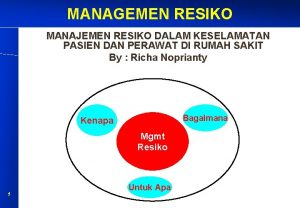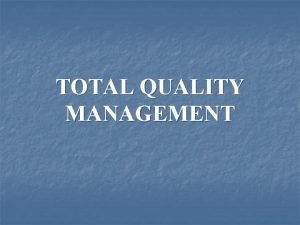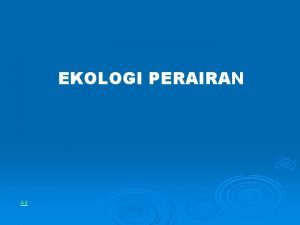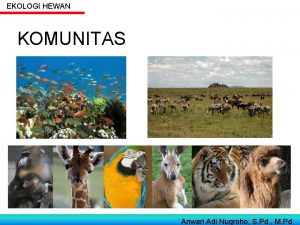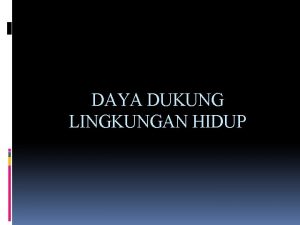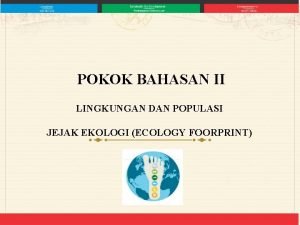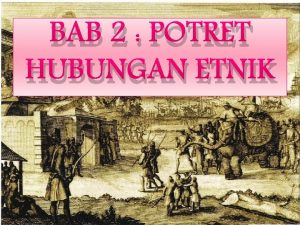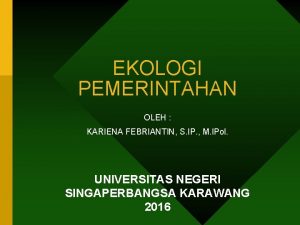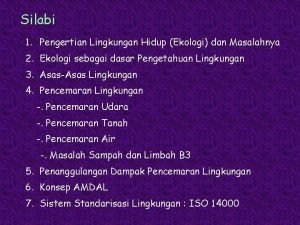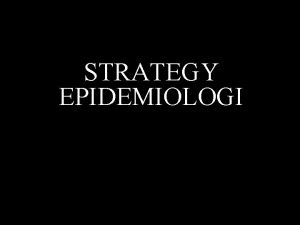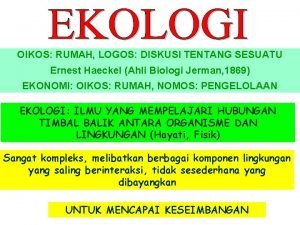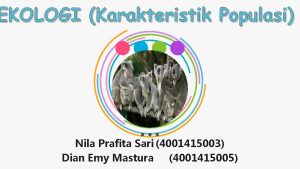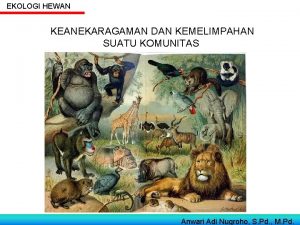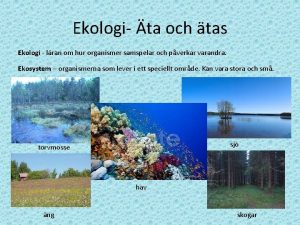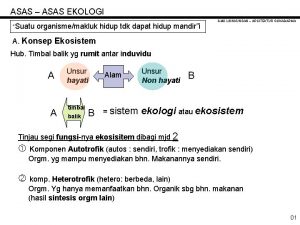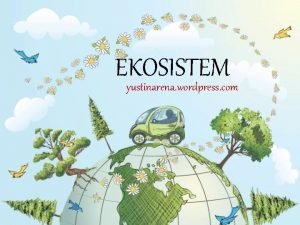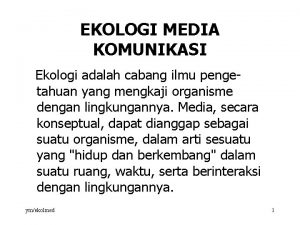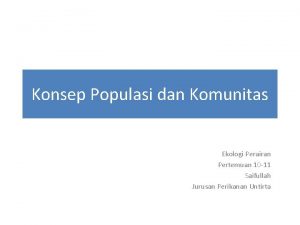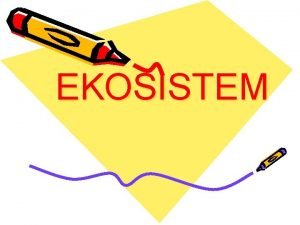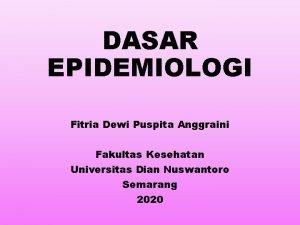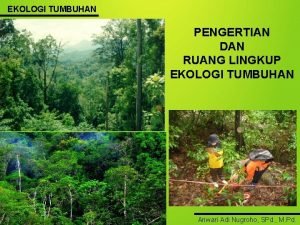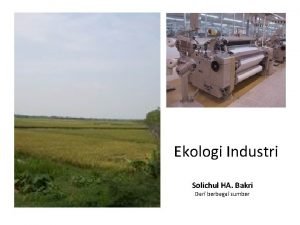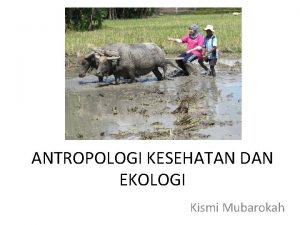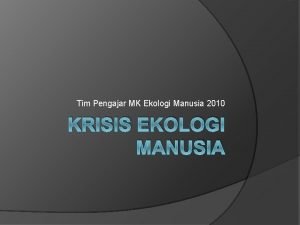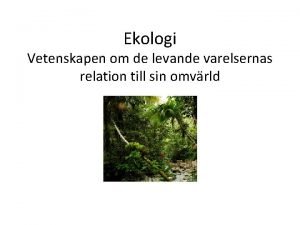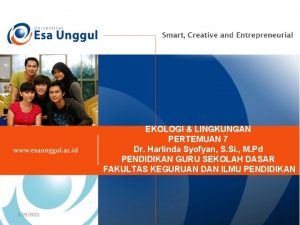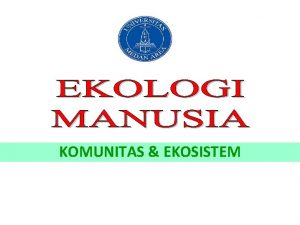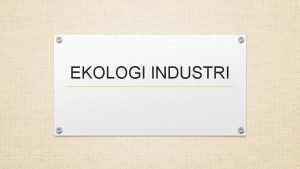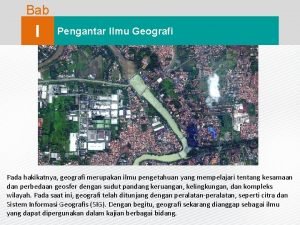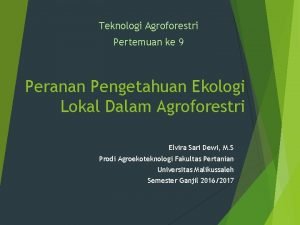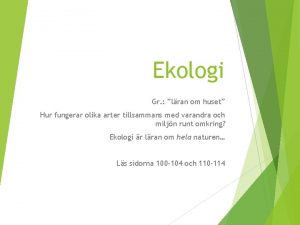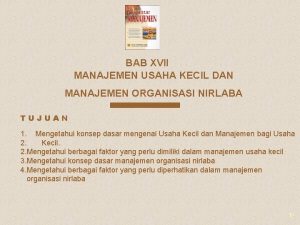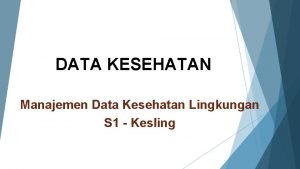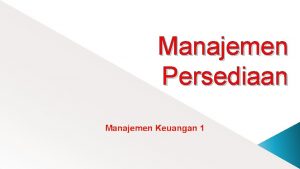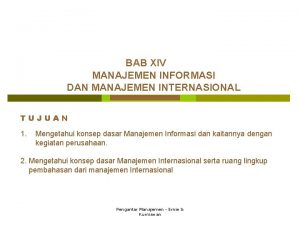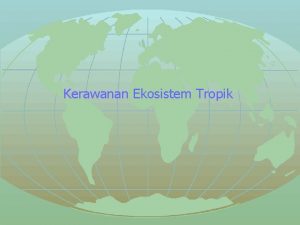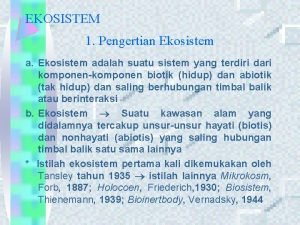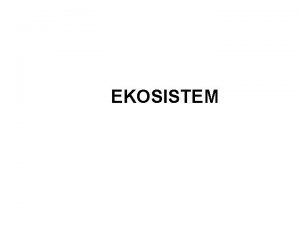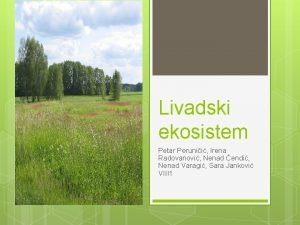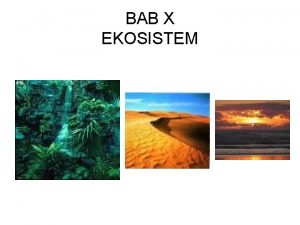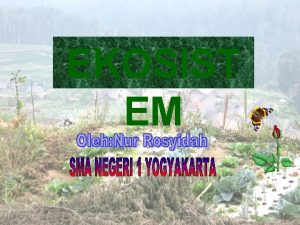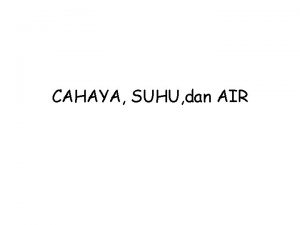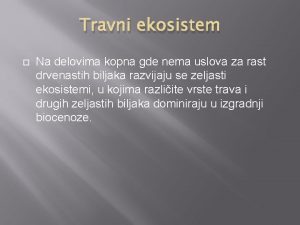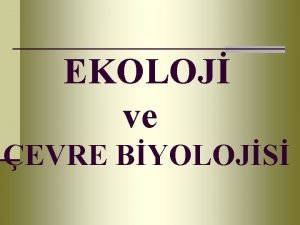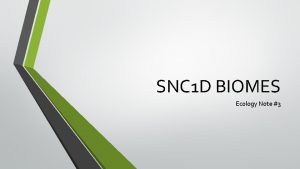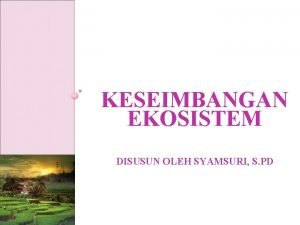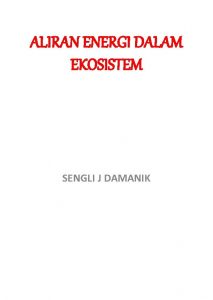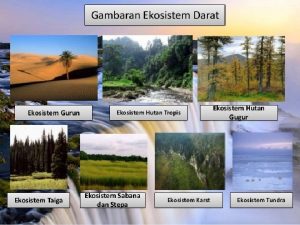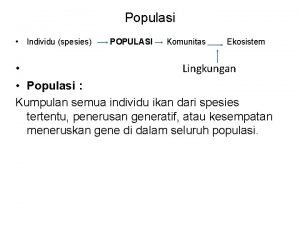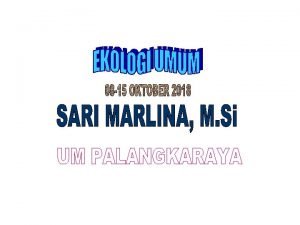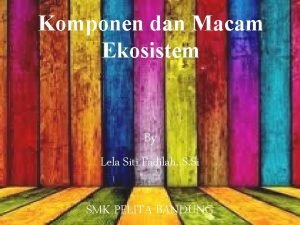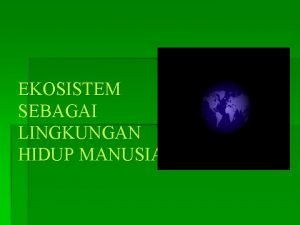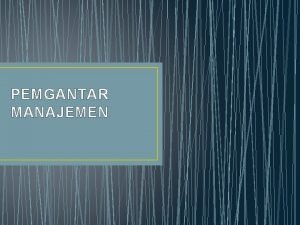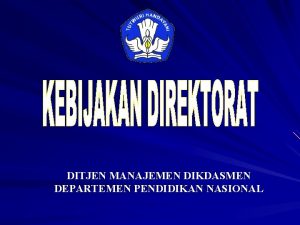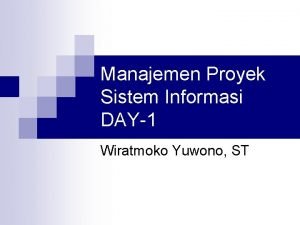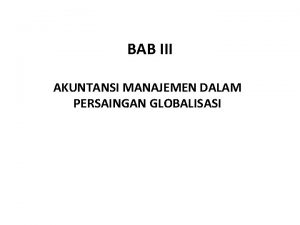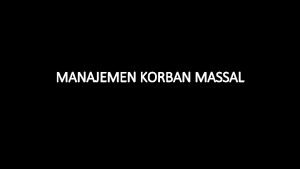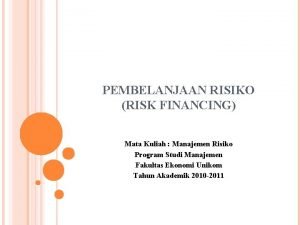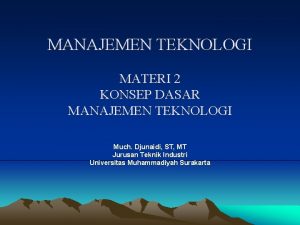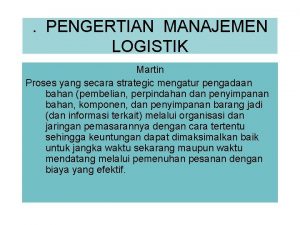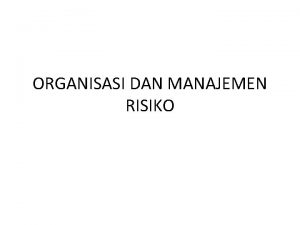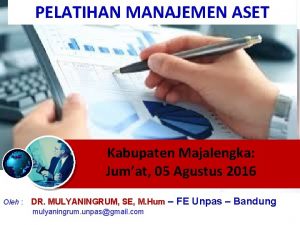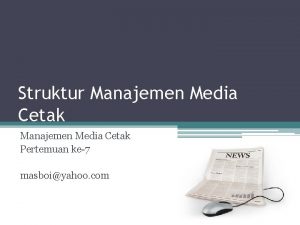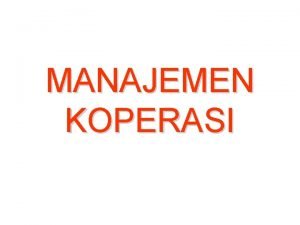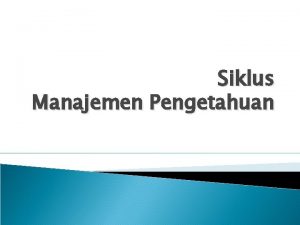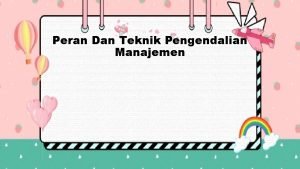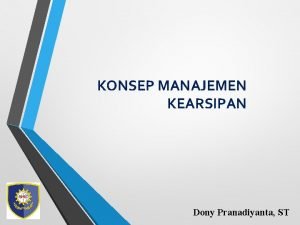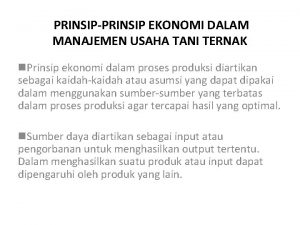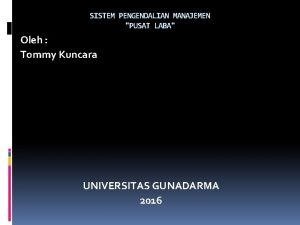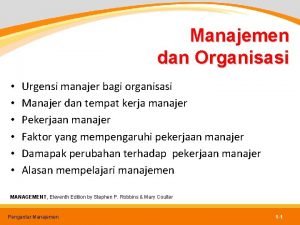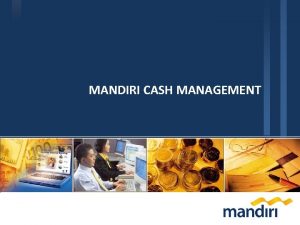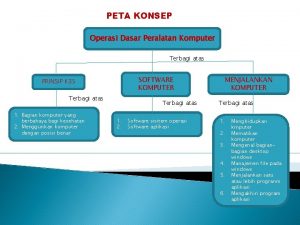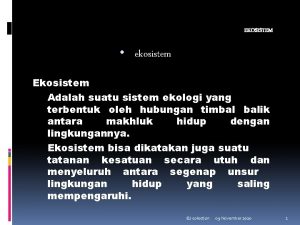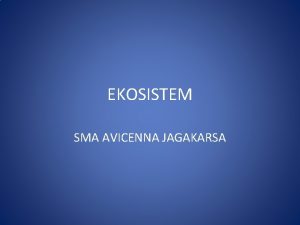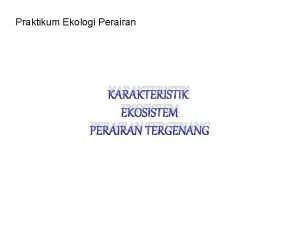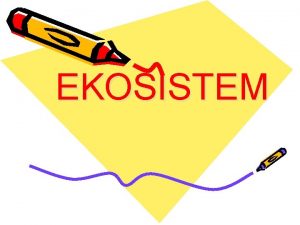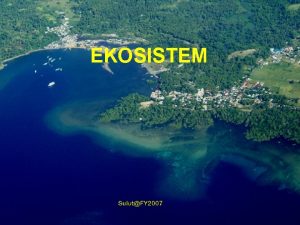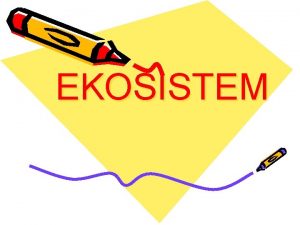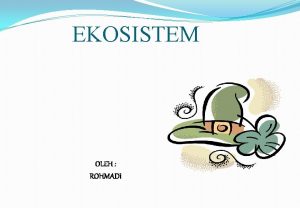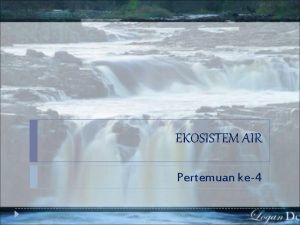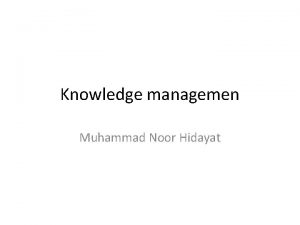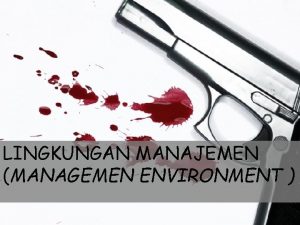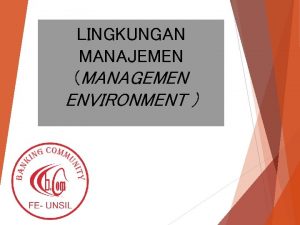MANAJEMEN EKOSISTEM 1 Ekosistem Ekologi Managemen Ekosistem 2






























































































- Slides: 94

MANAJEMEN EKOSISTEM 1

• Ekosistem • Ekologi • Managemen Ekosistem 2

Terminologi: • Biosfir: – Permukaan bumi – Terdiri atas banyak ekosistem • Ecosystem – Sistem yang terdiri atas komponen abiotik dan biotik (produsen, konsumen, dan pengurai), keduanya saling tergantung – Ukuran ekosistem bisa besar atau kecil 3

• Komponen abiotik (non-living components) di lingkungan – Air, angin, atmosfir (udara, angin), sinar matahari, Nutrients di tanah dan air, Heat (temperatur), Tanaman yang sudah mati (humus), etc. • Biotic factors (Living organisms)- – All the living organisms that inhabit an environment. – Plants, Animals, Insects, Microorganisms , etc. 4

• Produsen (mostly plants) – Tanaman hijau • Consumers – Herbivores and carnivores – Missing links in food chain kill above • Decomposers – Fungi, bacteria, insect 5

• Population – One species live in one place at one time • Community – All populations (diff. species) that live in a particular area. 6

• Habitat – Physical location of community - The place a plant or animal lives • Organism – Simplest level of organization 7

EKOLOGI Origin of the word…”ecology” • Greek origin • OIKOS = household • LOGOS = study of… • Study of the “house/environment” in which we live. 8

• Ecology is study of interactions between biotic and abiotic components • Ecology views each locale as an integrated whole of interdependent parts that function as a unit. • Ecology is an integrated and dynamic study of the environment. 9

• Ekologi merupakan kajian tentang interaksi yang terjadi diantara organisme dan lingkungannya: Biotik Abiotik • Kajian ini menerangkan bagaimana organisme hidup saling mempengaruhi dan mempengaruhi tempat (lingkungan) dimana mereka hidup 10

• All organisms depend on others directly or indirectly for food, shelter, reproduction, or protection. 11

• Abiotic factors- the nonliving parts of an organism’s environment. • Abiotic factors affect an organism’s life. 12

13

Ecosystems • All life is connected • Food chain is a web in reality • Broken links may destroy the web or force reorganization 14

Elemental Cycles • Nitrogen cycle – Atmospheric N 2 fixated by plants and bacteria to make NH 3 and other compounds – Bacteria convert NH 3 into NO 2 and NO 3 which plants use to make amino acids – Amino acids eaten by animals end up in waste products to decompose – Some bacteria remove NO 2 from soil to go back to N 2 in the air 15

16

17

18

Carbon Cycle Diagram Carbon in Atmosphere Decomposers break down dead things, releasing carbon to atmosphere and soil Fossil fuels are burned; carbon is returned to atmosphere Carbon slowly released from these substances returns to atmosphere Plants use carbon to make food Plants and animals die Bodies not decomposed — after many years, become part of oil or coal deposits Animals eat plants and take in carbon 19

The Carbon Cycle 20

Human Impact on Carbon Cycle: • Fossil fuels release carbon stores very slowly • Burning anything releases more carbon into atmosphere — especially fossil fuels • Increased carbon dioxide in atmosphere increases global warming • Fewer plants mean less CO 2 removed from atmosphere 21

What We Need to Do To Reduce Carbon Emission • Burn less, especially fossil fuels • Promote plant life, especially trees 22

Pengendalian Pupulasi • Pertumbuhan Eksponential – Mother & Father have multiple children (2 or more) increases population exponentially – Lifespan affects population but not exponentially 23

Kapasitas Tampung (Carrying Capacity) • • • Oxygen supply (more water organism issue) Food Supply Disease Predators (not much for humans) Limited available space 24

Impact on Environment • • CO 2 emissions related to overall population CO 2 is greenhouse gas Water usage (part of food supply) Waste products (rate of decomposition) 25

• Ekosistem memberi paradigma terbaik untuk mengintegrasikan komponen-komponen biotik (makluk hidup) dan abiotik (lingkungan), untuk menyelesaikan masalah riil Adaptable System • Tugas pengelolaan lingkungan: – Stabilitas struktur dan fungsi lingkungan – Juga kaitannya dengan aspek sosial, ekonomi, dan cultural (interaksi manusia dan lingkungannya) 26

Klasifikasi Sistem: Berdasarkan fungsinya • Isolated System – Tidak terjadi import dan ekspor material dan energi • Closed System – Terjadi import dan ekspor material, tetapi tidak energi • Open System – Batas-batasnya memungkinkan terjadinya pertukaran (impor dan ekspor) material dan energi – Kebanyakan ekosistem bumi termasuk dalam kategori sistem ini 27

Klasifikasi Sistem: Berdasarkan Intervensi Manusia • Natural System – Unaffected by human interference • Modified System – Affected to some extent by human interference • Controlled System – Fully affected by human interference, by accident or by design – Manusia berperan utama dalam sistem tersebut (misalnya sistem pertanian) 28

Hubungan Antar Komponen Ekosistem 29

• Ukuran fisik ekosistem dapat sangat kecil s/d sangat besar • Ekosistem biasanya dianalisis oleh system analyst • Ide manajemen lingkungan adaptif mengadopsi Pendekatan Ekosistem 30

Pendekatan Studi Ekosistem a. Conventional approach b. Abstraction of the system into a model leading to interpretation of mathematical conclusions 31

• Ecosistem dapat mengalami gangguan Ekosistem perlu diawasi dan dilindungi dari ancaman • Ekosistem dapat mengalami perubahan, baik secara alami maupun antropologis (pengaruh manusia) Perubahan dapat terjadi secara tiba-tiba, atau bersifat gradual • Pengelola Lingkungan tidak dapat mengelola ekosistem itu sendiri, melainkan mengelola interaksi dengan manusia dengan lingkungan 32

Konsep Manajemen Ekosistem Konsep Ekosistem: • Suatu kesatuan yang terintegrasi • Melihat sistem secara holistik bagaimana komponen-komponen yang terlibat saling berinteraksi dan berkerja secara bersama • Dapat diterapkan pada berbagai kasus, misalnya urban ekosistem, agroekosistem, dan sistem industri 33

• Pengelolaaan Lingkungan agak sama dengan Pengelolaan Pabrik, yaitu: To improve dan sustain output, dan to reduce costs • Konsep Ekosistem menekankan pada aspek keberkelanjutan, dengan tujuan menjaga integritas ekosistem, dan jika mungkin, menghasilkan pangan atau komoditi lainnya 34

• Pendekatan Ekosistem membantu dalam mendefinisikan skala spasial dan temporal pengelolaan • Analisis Ekosistem: – Ekosistem dapat dianalisis menggunakan teori sistem Teori sistem membuat situasi yang kompleks dan dinamis menjadi lebih dapat dimengerti dan diprediksi 35

• Teori sistem berasumsi: Measureable Causes produce Measureable Effects • Ada kecenderungan peningkatan usaha untuk mengkombinasikan model ekologis dengan aspek ekonomis 36

Contoh Manajemen Ekosistem • Pengelolaan Daerah Pesisir • Pengelolaan DAS (Watershed, Catchment Area) • Pengelolaan Agroekosistem • Pengelolaan Urban Ecosystem 37

Pengelolaan Daerah Pesisir • Berbagai aktivitas manusia berkonsentrasi di pesisir, kondisi pesisir dipengaruhi oleh berbagai fakror Perlu pengelolaan lingkungan, terutama pesisir yang rawan banjir, erosi, abrasi, eksploitasi mangrove • Global warming Permukaan air laut meningkat Pengelolaan pesisir menjadi lebih penting 38

Pengelolaan DAS (Watershed, Catchment Area) • DAS merupakan unit biogeofisik, biasanya dapat ditentukan batas-batasnya dengan baik, dimana agroekosistem, aktivitas manusia, dan sumberdaya air saling berinteraksi (saling mempengaruhi) 39

• Peneliti tertarik untuk mengetahui bagaimana perubahan penggunaan lahan (land use) berpengaruh pada hidrologi • Effek (Vegetasi, tanah) Output (aliran air: kualitas & kuantitas) • Penegelolaan DAS dapat dilakukan dengan model Manajemen Participatory 40

Pengelolaan Agroekosistem • Agroekosistem adalah ekosistem yang dimodifikasi oleh manusia untuk menghasilkan pangan atau produk lainnya • Sifat Agroekosistem: – Produktivitas – Stabilitas – Sustainibilitas – Equalibilitas 41

• Produktivitas: Output, yield, perolehan atau nit income from a valued product per unit of resource input. Contoh: kg padi / ha, kalori/ha • Stabilitas: Stabilitas terhadap perubahan, misalnya terhadap fluktuasi iklim • Sustainibilitas: Kapasitas sistem agroekosistem dalam mempertahankan produktivitas terhadap perubahan lingkungan degradasi akibat eksploitas • Equalibilitas: Pemerataan distribusi 42

Tujuan Pengegelolaan agar keempat aspeks tersebut optimum Kadang terjadi kontradiksi: • Produktivitas ↑ sustainability • Produktivitas sustainability↑ Ilmu pengatahuan perlu diaplikasikan • Tujuan pengelolaan agroekosistem lebih sering pada aspek sosioekonomi, dari pada aspek ekologis 43

Pengelolaan Urban Ecosystem • Pendekatan ekosistem dapat diterapkan pada kasus urban untuk mengidentifikasi strategi guna mereduksi, menfasilitasi pengelolaan limbah, kegiatan pertanian dengan penyediaan lapangan pekerjan 44

Applied Ecology 45

Diversity • Depends on: - number of species and abundance of each species in an ecosystem • Growth of population depends on: - Abiotic factors - Biotic factors Index of Diversity: d = N(N-1)/Σn(n-1) d: index of diversity N: total number of organisms of all species in area n: total number of organisms of each species in area 46

Impact of Humans • Manusia memiliki potensi besar “acaman” bagi hewan, tanaman, dan lingkungan • Pengaruh manusia begitu besar karena: - Teknologi mengubah dunia bergitu cepat - Jumlah populasi manusia meningkat pesat - Menggunakan sumberdaya alam dan menghasilkan limbah 47

Human Population Growth • Manusia mampu beradaptasi untuk survive di hampir semua habitat dan iklim • Populasi manusia meningkat tajam dan mengancam lingkungan • The population will eventually be limited by these factors: - food and water supply - disease and pollution - over-crowding - sudden changes in climate 48

Pollution • Atmospheric Pollution: Caused by combustion, exhaust fumes, livestock, waste dumps • Effects: - smoke, which damages air quality - carbon dioxide and Methane, which cause climate change - sulphur dioxide and nitrogen dioxide, which mix with rainwater to form acid rain - carbon monoxide, which is poisonous to humans and animals 49

• Water Pollution: Caused by deposition of substances into seas, lakes, rivers • Effects: - sewage and oil, which destroy habitats and kill animals - fertilisers and pesticides, which damage ecosystems 50

Ecological Niche • Describes how organisms in an ecosystem interact • What it does that affects or contributes to its surroundings • Includes: habitat, relationships and nutrition 51

Examples of Relationships (Interactions) Between Species Interaction Examples: Herbivory A primary consumer feeds on a producer . . Predation A consumer feeds on another consumer . . Mutualism 2 species live together with each providing benefit to the other via the relationship Parasitism A parasite lives on or within a host and obtains food from it. The parasite benefits, the host is always harmed Competition 2 species compete for the same resource if there is not enough to support both . . . . . . . . 52

Agroecosystems • Definition: formed by interactions between biotic (plants, microbes etc. ) and abiotic (temp. humidity etc. ) factors in a defined area, an agroecostystem influences the distribution and population of living organisms • Differs from natural ecosystems: - maintenance at an early successional state - monoculture - crops planted in rows - simplification of biodiversity - intensive tillage (untuk menghasilkan pangan) - use of organisms and artificially selected crops 53

• Merujuk pada kajian fenomena ekologis di lahan pertanian, seperti hubungan antara predator dan mangsa • Membutuhkan input untuk mempertahankan kesetimbangan, penggunaan pestisida mengganggu kesetimbangan dengan terbunuhnya organisme • Maintenance keeps pest populations at manageable levels: - ecosystems are ever changing systems - ecosystems follow food webs - All elements of an agroecosystem are closely linked. Disturbance to one has effects on others 54

• Humans have a huge impact on the planet. This includes intensive farming, selective breeding and pesticides/fertilisers • Impacts of Monoculture: 1. Genetic diversity is reduced, crops susceptible to disease 2. Fertilisers pollute groundwater 3. Pesticides pollute groundwater 4. Species diversity is reduced 5. Countryside less attractive • Crop rotation: breaks pests’ life cycles, improves soil texture and can increase soil nitrogen 55

• Inorganic fertilisers are most common but affect the environment • Benefits of organic fertilisers to ecosystem: 1. Compounds decompose slowly and prevent leaching 2. They are cheap 3. Can be disposed of on fields and not only in landfill sites 4. Improves soil structure and improves drainage and aeration 56

• Intensive farming can damage the environment. e. g. 57

• Pesticides can harm larger organisms. e. g. 58

• Fishing: Unsustainability: the using up of resources faster than they are produced so that they will not continue in the future e. g. North Sea Cod are over-fished so are reproducing slower than are being caught. Effect population is heavily declining 59

• Forestry: Humans burn wood or clear land for farming deforestation: 1) destroys habitats 2) causes soil erosion barren land flooding 3) causes pollution from combustion 4) increased levels of carbon dioxide as loss of photosynthesis 60

Aquatic biomes cover about 75% of the earth’s surface - Wetlands - Lakes - Rivers, streams - Intertidal zones - Oceanic pelagic biome - Coral reefs - Benthos 61

Industrial Ecology Lecture 13 62

Overview • • • Terminology Design for the Environment Natural Systems as Models Directions in Industrial Ecology Examples 63

Some Terminologies • Ecology: the study of the earth’s life support systems, of the interdependence of all beings on Earth (Odum, E. ) • Metabolism: sum of the processes sustaining the organism: production of new cellular materials (anabolism) and degradation of other materials to produce energy (catabolism) (Ray) 64

• Industrial Ecology: Aplikasi teori ekologi untuk sistem industri (Rejeski); melihat dunia industri sebagai suatu sistem alami, menggabungkan ekosistem lokal dengan biosfir (Lowe) • Industrial Metabolism: Aliran material dan enegi melalui sistem industri dan interaksi aliran tersebut dengan siklus biogeokimia (Erkman) • Industrial Symbiosis: Suatu sistem industri dimana waste dari proses sebagai sumberdaya (resources) bagi proses lainnya 65

More Terminology • Eco-Efficiency: Integrasi efisiensi ekonomis (financial return, profit, productivity, customer perception) dan efesiensi lingkungan (energy, emissions, environmental impacts. • Ecofactory: Desain teknologi sistem produksi terintergrasi (integrated design of production systems), mencakup DFE (Design for Environment) pada tingkat produk dan proses – dengan teknologi disassembling, reuse and materials recycling (Agency for Industrial Science and Technology, Japan) 66

More Terminology • Design for the Environment: Memperhatikan semua potensi implikasi pada lingkungan dari suatu produk: energy and materials used in the product; its manufacture and packaging; transportation; consumer use, reuse, and recycling; and disposal. • Df. X • Design for Recycling • Design for Disassembly • Design for Remanufacturing 67

Resource & energy flows Linear model unlimited resources ecosystem unlimited waste 68

Resource & energy flows Semi-cyclical model limited resources and energy limited ecosystem waste 69

Resource & energy flows Cyclical model energy ecosystem Source: Graedel, T. E. , “On the concept of industrial ecology”, Annual Review of Energy and Environment, no. 21, 1996, 70 p. 77.

Natural Systems • Function as an integrated whole • Minimize waste: Tanaman atau hewan hidup atau yang sudah mati dan limbahnya adalah “food” bagi something • Decomposers (microbes and other organisms) consume waste and are eaten by other creatures (makluk lain) in the food chain 71

• Toksin tidak disimpan atau ditransfer dalam jumlah banyak (borongan) tetapi disintesis dan digunakan sejumlah yang diperlukan oleh spesies secara individu • Materials are continually circulated and transformed in elegant ways. • Nature runs largely off solar energy • Nature is dynamic and information driven, identity of ecosystem players is defined in process terms 72

The Industrial Ecology Paradigm • Bumi adalah sistem ekologis tertutup: the scale and design of development is inconsistent with long-term ecological survival • Human society and natural systems have co -evolved – Alam memiliki nilai intrinsik, ditampakkan melalui aktivitas ekonomi – Moral dan etika tindakan ekonomi harus memperdulikan lingkungan 73

• “Ecologize Economy”, an economy based on service, not goods, or quantity, of life • Moral/ethical transformation to instill environmental concerns • Technological realism, precautionary principle for uncertainty 74

• Industry mimics nature (Industri meniru alam) – Waste from one organism is food for another – Everything is connected by cyclic processes – Living off nature’s interest • Shift in thinking – Past: Remediation – Present: Treatment, storage, and disposal – Future: Industrial metabolism and the industrial ecosystem 75

• Management of the nature-industry interface • Ultimate goal: bringing the industrial system as close as possible to being a closed-loop system with near complete recycling of materials. • Is zero waste achievable, considering thermodynamics, or is zero environmental impact a more feasible target? 76

Framework for Industrial Ecology 1. Improve metabolic pathways of industrial processes and systems 2. Create loop-closing industrial systems 3. Dematerialize industrial output 4. Systematize patterns of energy use 5. Balance industrial system input and output to ecosystem activity 6. Align policy to conform with long-term industrial system evolution 7. Create new action-coordinating structures, communicative linkages, and information 77

Industrial Metabolism • A “Big Picture” analytic tool developed by Robert Ayres • Examination of the total pattern of material and energy flows form initial extraction of resources to final disposal of wastes • Factors in the real value of nonrenewable resources and environmental pollution, gives value to externalities 78

• Can be used for regions (the Rhine basin), specific industries (aluminum) or specific materials (heavy metals) • Suggests some measures of sustainability: ratios of potential to actual recycled materials, virgin to recycled materials, materials productivity 79

Problem On average, only 6% of resources taken from the environment end as products. Other 94% is waste. Is it really waste? Or is it a by-product that can be used elsewhere? Source: Lowe, Warren, Moran, 1999. 80

Industrial Symbiosis • Most commonly understood meaning of industrial ecology • Waste materials and energy serving as inputs or resources for other industrial processes • Also referred to as “By-product synergy, ” “green twinning, ” “zero-waste/zeroemissions, ” “cradle-to-cradle eco-efficient manufacturing” • Evolving into the concept of an Eco-Industrial Park where co-locating 81

Conventional Waste Management Brewery waste dumped into oceans to destroy coral reefs Brewery Muck dumped on fields Mushroom Growing Waste piles up Chicken Raising Methane Gas Production Fish Ponds Methane vented Muck cleaned out 82

Industrial Ecology Brewery waste fertilizes mushrooms Brewery Mushroom residue feeds chickens Mushroom Growing Chicken Raising Chicken waste is composted Solids become fish food Methane Gas Production Fish Ponds Nutrients used in gardens Hydroponic Gardening 83

Back to Industrial Ecology • The name “industrial ecology”- why? – Models of non-human biological systems and their interactions with nature are instructive for industrial systems that we design and operate – The biological model is clever, a closed-loop materials system – Recent better understanding of the materials and energy flows of biological systems 84

• Questions: – How do you apply the biological principles of resilience (kegembiraan), limiting factors, other rules? – What about the low efficiency of natural systems (<5%)? • Bottom Line: – Lessen (Kurangi) (dramatically the impacts of our industrial system) – Management of the industry-natural systems interface, match input-output of the manmade world to the constraints of the biosphere 85

Implementing Industrial Ecology • Technical Basis – – Choose material Design the product Recover the material Monitor the Situation • Institutional Barriers and Incentives – – Market and informational barriers Business and Financial barriers Regulatory barriers Legal Barriers • Regional Strategies – Ecoparks, Eco-Factories 86

Candidates for Lessening Impacts • Zero Emissions Systems – Orderly progression from Type I (high throughput mass and energy, no resource recovery) to Type III (closed loop) – Eliminate ‘leaks’ • Material Substitution – More durable, less waste, more recyclable 87

• Dematerialization – Theory of Dematerialization: the more affluent a society becomes, the mass of materials required diminishes over time – Must result in less waste to be effective • Functionality Economy – What is the function? Do we need automobiles? Waste from telephone disposal (old phones were leased and returned!) 88

Design for the Environment (DFE) • Considers all potential implications of a product – – Energy & materials Manufacture & packaging Transportation Consumer use, reuse or recycling, and disposal • A holistic design process • Example: automobile bodies (Iron, plastics, & aluminum) 89

• Tradeoffs: virgin vs. recycled, energy at each stage, materials recyclability, manufacturability, costs • Challenges: – Adequate database about materials and their impacts – Concurrent engineering to work across R&D, marketing, quality. . – Public sector involvement for defining values for trade-off 90

DFE Example - Xerox Raw Materials Build New Components Certified Reprocessing Closed Loop Recycling Return to Suppliers Certified Reprocessing Customer Use Sort/Inspect Third Party Recycling Remove Materials for Recycling Alternative Uses Deliver Dismantle Disposal Goal: Zero to Landfill 91

The Eco-Industrial Park (EIP) • A community of manufacturing and service businesses seeking enhanced environmental and economic performance through collaborating in the management of environmental and resource issues. • The interactions among companies resemble the dynamics of a natural ecosystem where all materials are continually recycled. • Industrial Park: restricted meaning in terms of geography and ownership. 92

• An EIP is a relate estate property that must be managed to bring a competitive advantage to its owners. • An EIP is a “community of companies” that must manage itself to provide benefits for its members. • Decisions are based on maximizing the profitability of the EIP as a whole • Transfer prices negotiated so each member will be as profitable as without the EIP 93

Selamat Belajar 94
 Peran manajemen risiko dalam keselamatan pasien ppt
Peran manajemen risiko dalam keselamatan pasien ppt Introduction to total quality management
Introduction to total quality management Ekologi berasal dari bahasa
Ekologi berasal dari bahasa Komunitas dalam ekologi
Komunitas dalam ekologi Apa itu daya lenting dan daya dukung
Apa itu daya lenting dan daya dukung Tingkat trofik 2
Tingkat trofik 2 Contoh jejak ekologi
Contoh jejak ekologi Teori freudian dalam hubungan etnik
Teori freudian dalam hubungan etnik Materi kuliah ekologi pemerintahan
Materi kuliah ekologi pemerintahan Arti ekologi
Arti ekologi Pengertian ekologi pemerintahan
Pengertian ekologi pemerintahan Desain studi ekologi
Desain studi ekologi Oikos dan logos
Oikos dan logos Iteropar
Iteropar Rumus indeks shannon wiener
Rumus indeks shannon wiener Ruang lingkup ekologi
Ruang lingkup ekologi Detritivus
Detritivus Producenter ekologi
Producenter ekologi Asas ekologi
Asas ekologi Apa itu ekologi
Apa itu ekologi Contoh gambar jaring jaring makanan
Contoh gambar jaring jaring makanan Cabang ilmu ekologi
Cabang ilmu ekologi Indeks keanekaragaman
Indeks keanekaragaman Ekosistem tanah
Ekosistem tanah Pendekatan ekologi
Pendekatan ekologi Ruang lingkup ekologi
Ruang lingkup ekologi Ruang lingkup ekologi tumbuhan
Ruang lingkup ekologi tumbuhan Ekologi industri
Ekologi industri Antropologi kesehatan dan ekologi
Antropologi kesehatan dan ekologi Contoh krisis ekologi
Contoh krisis ekologi Ekologi
Ekologi Peta konsep tentang ekologi
Peta konsep tentang ekologi Manfaat mempelajari ekologi administrasi negara
Manfaat mempelajari ekologi administrasi negara Komunitas dalam ekologi
Komunitas dalam ekologi Ekologi berasal dari kata oikos dan logos logos berarti
Ekologi berasal dari kata oikos dan logos logos berarti Geografi
Geografi Mind map karbohidrat
Mind map karbohidrat Istilah ekologi pertama kali diperkenalkan oleh
Istilah ekologi pertama kali diperkenalkan oleh Peranan pengetahuan ekologi lokal dalam sistem agroforestri
Peranan pengetahuan ekologi lokal dalam sistem agroforestri Anrikning ekologi
Anrikning ekologi Skillnad mellan habitat och nisch
Skillnad mellan habitat och nisch Manajemen usaha kecil dan manajemen organisasi nirlaba
Manajemen usaha kecil dan manajemen organisasi nirlaba Jelaskan definisi dari data dan data kesehatan
Jelaskan definisi dari data dan data kesehatan Hubungan manajemen persediaan dengan manajemen keuangan
Hubungan manajemen persediaan dengan manajemen keuangan Manajemen informasi dan manajemen internasional
Manajemen informasi dan manajemen internasional Kerawanan ekosistem adalah
Kerawanan ekosistem adalah Habitat adalah
Habitat adalah Rantai makanan bioster
Rantai makanan bioster Satuan ekosistem yang merupakan populasi adalah
Satuan ekosistem yang merupakan populasi adalah Lanac ishrane u bari
Lanac ishrane u bari Detrivor adalah
Detrivor adalah Livadski ekosistem
Livadski ekosistem Ekosistem tanah lembap
Ekosistem tanah lembap Ekosist
Ekosist Ciri ekosistem air tawar
Ciri ekosistem air tawar Planinske rudine
Planinske rudine Su döngüsü
Su döngüsü Ekosistem
Ekosistem Ekosistem disusun oleh
Ekosistem disusun oleh Assimilassi
Assimilassi Ciri ekosistem air
Ciri ekosistem air Spesies populasi komunitas ekosistem
Spesies populasi komunitas ekosistem Siklus nitrogen
Siklus nitrogen Ekosistem air
Ekosistem air Pendekatan ekosistem dalam ilmu lingkungan
Pendekatan ekosistem dalam ilmu lingkungan Tingkatan manajemen adalah
Tingkatan manajemen adalah Definisi teknik lingkungan
Definisi teknik lingkungan Manajemen dikdasmen
Manajemen dikdasmen Pengertian manajemen proyek sistem informasi
Pengertian manajemen proyek sistem informasi Akuntansi manajemen dalam persaingan globalisasi
Akuntansi manajemen dalam persaingan globalisasi Komponen utama sistem informasi manajemen rumah sakit
Komponen utama sistem informasi manajemen rumah sakit Manajemen korban massal
Manajemen korban massal Contoh risk financing transfer
Contoh risk financing transfer Marketing plan
Marketing plan Materi manajemen teknologi
Materi manajemen teknologi Siklus manajemen risiko (proses mapping risiko)
Siklus manajemen risiko (proses mapping risiko) Pengertian manajemen logistik
Pengertian manajemen logistik Apa manfaat
Apa manfaat Kursus management
Kursus management Struktur manajemen media cetak
Struktur manajemen media cetak Konsep manajemen memori
Konsep manajemen memori Perangkat hukum eksternal dalam manajemen koperasi adalah
Perangkat hukum eksternal dalam manajemen koperasi adalah Evolusi pemikiran manajemen
Evolusi pemikiran manajemen Konsep dasar manajemen pengetahuan
Konsep dasar manajemen pengetahuan Faktor keberhasilan implementasi strategi
Faktor keberhasilan implementasi strategi Peran dan teknik pengendalian dalam manajemen
Peran dan teknik pengendalian dalam manajemen Tujuan manajemen kearsipan
Tujuan manajemen kearsipan Titik pusat manajemen
Titik pusat manajemen Manajemen keuangan syariah
Manajemen keuangan syariah Fungsi produksi
Fungsi produksi Mata kuliah manajemen proyek sistem informasi
Mata kuliah manajemen proyek sistem informasi Sistem pengendalian manajemen pusat laba
Sistem pengendalian manajemen pusat laba Universalitas manajemen
Universalitas manajemen Cash management mandiri
Cash management mandiri Peta minda komponen komputer
Peta minda komponen komputer
